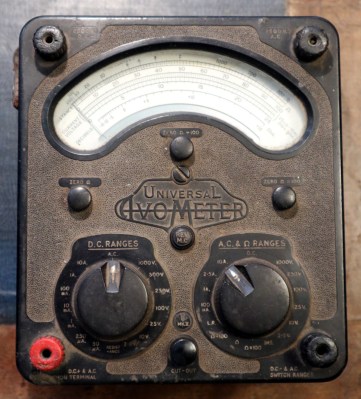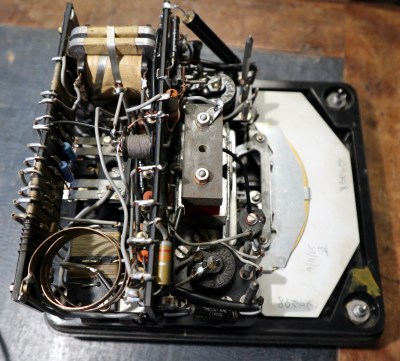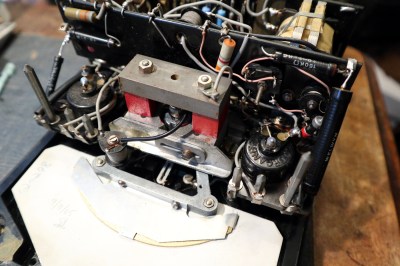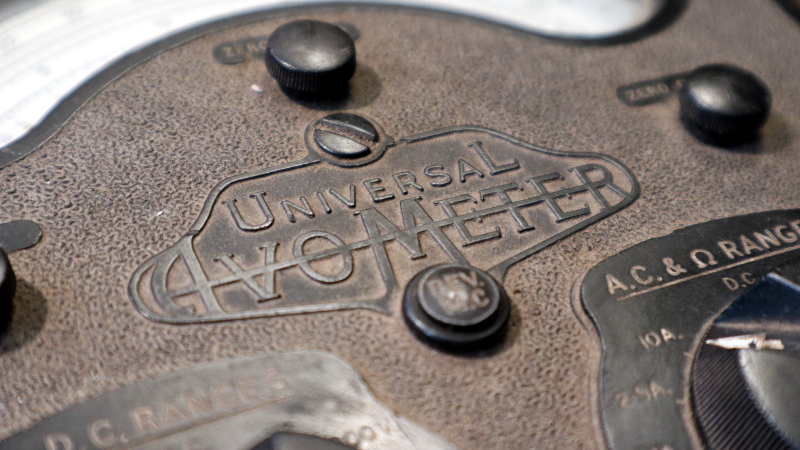I’m moving, and in the process of packing all of my belongings into storage boxes to disappear into a darkened room for the next year. Perhaps I could become one of those digital nomads I hear so much about and post my Hackaday stories from a sun-kissed beach while goldfish shoals nibble at my toes. But here in a slightly damp British autumn, box after box of a lifetime’s immersion in tech needs sorting and directing. Why on earth did I hang on to three Philips N1500 VCR system video cassette recorders from the early 1970s! (Don’t worry, those have found a good home.)
Say Hello To An Old Friend Of Mine

As I was packing up my bench, I happened upon a multimeter. I have quite a few multimeters and this isn’t the first time I’ve written about these indispensable instruments, but this one’s a little special.
It’s a treasure from my youth, that most venerable of British test equipment: the AVO 8. This was the ubiquitous multimeter to be found in all manner of electrical and electronic workshops across most of the 20th century, and remains to this day one of the highest quality examples of its type.
It’s a relatively huge Bakelite box about 190mm x 170mm x 100mm in size, and it is instantly recognisable by its dual rotary selector switches and the window for viewing the needle, which forms a characteristic circular arc kidney shape.
The earliest ancestors of my meter appeared in the 1920s, and the first model 8 in the early 1950s. Mine is a Mk III that a penciled date on the inside of its meter movement tells me was made in November 1965 and which I bought reconditioned from Stewart of Reading in about 1991, but manufacture continued until the last Mk VIII rolled off the production line in 2008. It’s to my shame that my AVO is a bit dusty and that maybe I haven’t used it much of late, but as I picked it up all the memories of using it to fix dead TV sets and set up optimistic experiments in radio came flooding back. If there’s one instrument that connects me to the youthful would-be electronic engineer that I once was, then here it is.
A Very Different Approach To A Meter
To fully appreciate the AVO 8, it’s time for a teardown, for a glimpse both at how a very high quality analogue multimeter is built as well as how such things were designed at the dawn of the Jet Age. Dismantling it is very easy, a couple of screws allow removal of the battery compartment cover on the side above the meter, and six screws in the sides of the meter undo to allow the Bakelite tub to be eased away from the front face.

It’s first worth a quick peek in the battery compartment, where there would be two batteries for the various resistance ranges. One is the familiar D cell while the other is a BLR121, a curious 15 V pile of cells of the type once used in devices such as hearing aids and camera flashes. This cell is still available from specialist suppliers for AVO owners, but another option has been to incorporate a little switching regulator to generate the required potential. The battery compartment as well as the high-voltage terminals make contact with the rest of the meter via a series of brass stand-offs that engage with springy metal fingers as the case is closed, and on the back of the battery case are mounted the high-voltage dropper resistors.
Turning attention to the meter itself, and immediately we are in a world of electronics from another era. The meter movement has a full-scale deflection of 50 μA and us a significantly substantial affair whose magnet alone is larger than many modern panel meters in their entirety. The parallax mirror is a substantial piece of glass mirror fixed to the back of the scale — a nice touch.

The rotaty switches don’t use the tag-and-wiper method you might expect, instead relying on a set of springy copper finger contacts of the type you might see in older relays, that are pushed down by cams on the rear of the knob mechanism. At the bottom is a substantial cut-out mechanism, and as a demonstration of the engineering quality its latch has a ruby bearing you might otherwise expect to see in a wristwatch.
Above the switches and cut-out are a pair of insulator bars that serve as both an array of solder tags for wiring as well as support for wire-wound resistors and discrete components. There is also a transformer for the AC ranges, and a high-current shunt resistor made from a coil of brass strip. Having the meter open on the bench surrounds it with that wonderful old-electronics smell of phenolic resin, and suddenly I have the urge to work on a vacuum tube TV from the 1950s again.
It’s clear then that the AVO remains an extremely high quality instrument, and is still a useful and accurate multimeter well into its sixth decade. I feel guilty then that I’ve neglected it in favour of a digital meter that cost an order of magnitude less. So why has it remained on the shelf then? An obvious answer might be that as an analogue meter its 20 kΩ/V sensitivity can’t match the high impedance of its digital rival, but that’s probably not the real reason. It’s seductive to carry a feather-light handheld unit rather than one the size of a medium-sized building block. That’s the real benefit of modernity: miniaturisation. I’ll try to use the AVO more on the bench because it’s a fantastic instrument. But will it regain its place as my main meter? Probably not. After all sometimes it’s better to stay in 2020 rather than 1950.
















Gorgeous meter there, Jenny! It’s in a class all alone, more or less. Fun, fun fun!
I love the AVO meters handed down to me by my Dad. Have two in my lab, and they’re both rock solid and accurate after 50 years. They’re built like a tank.
How much did they cost? Here in.the states we cut our teeth on the Simpson model 260 back in the 1960’s. They still make them but everybody went to the better auto ranging digital meters
I was similarly impressed by the Avometer in 1973 when I got to know the Serviceman (Norm) for our newly installed Cambridge Stereoscan SEM at the Botany School, Melbourne University. The SEM was basically an analogue device at that time (but a lovely bit of kit to work with) and he only ever serviced it with an Avometer. When I found one on eBay recently I snapped it up purely for nostalgic reasons. I cannot use it as it does not have the lid for the battery compartment or any other clue for how to fit batteries. Is there a www site with physical dimensions and circuit diagrams so I could 3-d the compartment lid and rig up power source(s)? It seems a shame not to fire up the grand old dame once again, even if just to show the grandchildren.
Which Model and Mark do you have? This guy has posted the full manual for the Avo 8 Mk 5 as HTML pages with the circuits and drawings – https://www.petervis.com/avo-meters/avo-8-mk-5-manual/avo-8-mk-5-user-manual.html There are also various sites with PDF downloads, but they are all different marks.
It is an 8MK II . Clips for the batteries are good. A bit of foam padding has gone crumbly. I will checkout your recommendation on the websites. Thank you SID1950. I was born in 1950 too!.
And this site has lots of pics, including of the battery compartments, and info about the differences between the marks. It looks like the later marks had different batteries. http://www.richardsradios.co.uk/avo8.html
I saw the photo of the meter, and knew it was going to be Jenny writing the article!
Go Jenny !! I like your articles.
Thanks :)
Amazing what a person (re) discovers during a move. I found some LM301s, 1972 ua741s, germanium transistors, a new-in box 1985 Kikisui scope, and other stuff that had been forgotten, or was previously unknown and from former consulting partners.
Would like to hear of Ms. List’s experiences if she attempted to donate some of her components/materials/equipment and the reaction, if any, of her local ‘hacker’ community.
“Would like to hear of Ms. List’s experiences if she attempted to donate some of her components/materials/equipment and the reaction, if any, of her local ‘hacker’ community.”
I’m sure they are well aware of her ability to mash metal between a hammer and anvil.
In other words, they would carefully measure any words before speaking them.
B^)
My local hacker community has plenty similarly afflicted, I assure you. :)
Memories… the electronics shop of the radio & TV operation I started working for after school in the mid 70s had two of the AVO 8s. Still deserving of a place above your bench; I have my remaining analog meter sitting up, facing forward, with leads hanging there for immediate use.
Good luck with the move. Will the new digs provide space for a bigger workshop?
What a nice article and how nice to learn of such a venerable piece of test equipment. Over here in the states I have an old Weston portable VTVM from ebay (like the one my dad used in the 50’s – 60’s). It has 45V (B+) and 1.5V (filament) bateries and one 6418 subminiature tube. Thanks for sharing your article; great pictures too!
Ah, yes. I worked in Pye Telecom, Ditton Works, Newmarket Rd, Cambridge in the 1960’s and the Avo 8 was the standard meter for doing the two way radios alignment & troubleshooting due to its 20K per volt internal resistance. All professional and military electronic equipment test points of the day were made for a AVO 8. Yep, the meter would actuate a mechanical needle acceleration cut out if you applied High voltage to a Low Voltage or current range, even so if you applied enough of a overload it it wasn’t always effective, so we saw many a bent needle as the young apprentices often misused them.
I worked briefly at the Newmarket Road site just before it closed and we all moved to St Andrews Road. This was late 1970s. I hear it’s now converted into flats. Very sad. I digress. I still use my old Avo meter, but almost only for measuring current, such as when working on power amplifiers. For everything else the modern lifhtweight digital multimeter wins everytime. I wouldn’t be without the old Avo though. It’s a classic and will surely outlive its digital offspring.
Just got frustrated with flat batteries in my digital multimeter, made me wish I had a good M/C meter. Reminded me of a time (1965) in Antarctica checking a high impedance HV device, and realised that the AVO 8 had a higher impedance that the new fangled HP VTVM I also had on hand.
Hi Alan here Taupo New Zealand.
I bought my first Avo8 in late 60s but then added to collection as I visited retiring electricians who were closing down their cluttered workshops.
So now I have four, covering Avo 7,8 and 9.
But what interests me is the number of electronic companies in the Cambridge Huntingdon area.
There must be a magnet which attracts them to that area.
My favourite has to be Quad Huntingdon.
Regards Alan
How I longed for one of these as a teenager in the 1970s, but I couldn’t afford one. Now I have Mk-II and a Mk-V. I like to use them occasionally when working with equipment from the matching era: the Mk-II with 1950s valve radios, the Mk-V with 1970s and 1980s stuff. But that odd battery is a pain!
Interesting. In my youth, Avomet was all one could use for A V measuring here around. It was simply a synonym for such device as nothing else was available. However, it was totally different to Avometer and I did not know until today something with such similar name exists.
https://sk.wikipedia.org/wiki/Avomet#/media/S%C3%BAbor:Avomet-front.jpg
https://sk.wikipedia.org/wiki/Avomet
No battery needed, it used the measured circuit energy (Depréz d´Arsonval system).
The picture of the AVO movement brought back memories. I used to calibrate them in my first job after leaving school. To meet specification they were required to be within 1% at full scale deflection. The slotted bar is a magnetic shunt which can be moved more or less across the gap for calibration. If the bar was fully back and the movement was still reading low, The magnets were flat. I would wind 20 turns of wire around the magnets (red parts in the picture ) and connect it to a big box of capacitors charged up to rectified mains voltage, then discharge the caps with a relay I made which used polished (old) penny coins as contacts (they needed to be replaced fairly often). This would remagnetise the magnets. Needless to say the movement coil had to be removed during this operation. The pivots ((like needle points which sat in tiny ruby cups) on the movement were cleaned by pushing them into dried pith collected from the small branches of a buddleia bush out in the yard. The movement has balance bars onto which I would melt tiny drops of wax from a cocktail stick so that the meter would read the same in any orientation.
Amaze your friends – the cutout should operate if you drop an eraser tipped pencil vertically onto it from a height of four inches.
Jenny, that was a real blast from the past! Avo 8 & 9 models were in use in all the studios and edit suites I worked in through the 70s, 80s and 90s, and one work shop still had one in 2004! They were great meters, beautifully made and super accurate. Your piece and one of the comments set me off down the rabbit hole. I found a site with lots of service manuals https://www.opweb.de/english/company/AVO – and Richards Radios! http://www.richardsradios.co.uk/index.html I’ve bookmarked that one, as I could spend days reading and looking at the pictures! On Ebay the prices vary dramatically.
I work for an engineering company in Cambridge and we still have a Avo in our test gear
Is the battery compartment picture missing?
Whenever I bought a mixed lot of test equipment at auction, usually from commercial and medical sources, there was often an AVO amoungst it as it was the defacto meter for field servicing for decades. As such I have about 5 under my desk here now, including both a fairly young avo 8 mk 5 and mk 7 which are significantly lighter than the older ones. Other end of the scale is a Mark 7 original, which is a tin cased beast from the 50’s. Still weighs a ton though. They are very good at DC current measuring as they do a good 10A and you can wrap wires on the terminals directly fairly easily…
Mines a mark 6
My first job, back in 1980, was a tech at polytech. I spent a lot of my time repairing the AVO meters after the students damaged them. Mostly replacing current shunts.
I used to repair TVs, and the Avo Model 8 was referenced in Radio and TV Servicing for measuring voltages in the service guides for all 60s and 70s TV chassis. I still have an Avo Multiminor mark IV and an Avo Model 8 mark V. The big one is not my go-to meter any more, but it does do useful work – and of course it doesn’t need a battery for most measurements. The multiminor is in use quite regularly.
Dang! We had these at my university electronics lab! I’ve used these a few times, I think we have one here at work somewhere as well.
Nice to find this – I’ve just refurbished a Model 8 MkII and it works perfectly (not calibrated of course). There are so many people who still seem to prefer this type of multimeter and yet it is not easy to buy nowadays.
There are several for sale second hand of course but most require some tlc
So can anyone help me please? I have model 8 and when I select Ohm/100 The meter reads negative with selection 10mA and 1mA,. On Ohm select 10mA it read 1400 Ohms, on 1mA it read 4500 Ohms and on Ohm x100 10mA reads 400 Ohms 1mA it reads 500 Ohms. Weird Eh? Any help would be appreciated
Hi, I don’t quite understand your question. If you have selected any Ohms from the rhs the only selection available on the lhs is Resistance. Any other combinations are not designed for use.
Have I misunderstood?
Hi. I have found an old AVO meter model 8 MK 2 that I was given by my uncle back in the late 70’s.
I would like to sell it to someone who would appreciate it but have no idea where I could offer it and how much it might be worth.
Can anyone give me some pointers please?
Hi Everyone
I used to repair all models of Avo’s and Meggers. I started straight from school in the officially approved Avo Service Department of Farnell Instruments in Wetherby straight from school in Oct 1971.
The date mentioned in the article on the back of the scaleplate is the date the movement was repaired,/tested the manufacturing date is on the front of the scaleplate after the Ser No Month and Year 1071 is October 1971.
The repair date will be followed by the initials of the person who carried out the repair if by any chance it was me initials are DC.
Hi
Do you have a service manual for the mkII Avo .
cheers
Richards Radios have a good library of info http://www.richardsradios.co.uk/AVO/AVO8%20MkII%20Instructions.pdf
Hello Stanley
No Sorry no longer have manuals when I shut down the Business (as we had our own business in the end) I sold all my Equipment, Spares and documentation. I may be able to help you from memory if you would like to contact me.
I still own, a Model 8 MkIII, and for some jobs it is way more effective than a digital meter – when testing Neve Channel amps the speed of movement of the needle could tell you quite a bit about the time constants in R/C circuits…..
I own a ago 8 and fitted 5 coin cells in series to getthe15v for high resistance range its well made and still works the last ago 8 multimeter used printed circuits and were not ax good quality I also have a fluke ex military multimeter that’s good and it’s made in USA the latest fluke meters are chinese imports with fluke name on them we have a new Tektronix scope at work and it’s chinese
Just got myself an 8 Mk 7. Was a technician at Racal Guardall at Newbridge, and we’d just acquired Chubb security. The AVO was my go-to. Fond memories.
Hi Robert
Sorry for the late reply I have just noticed your post.
Its now 20 years since I stopped working on instrumentation but I trained originally on Avo’s.
using my memory only I think your problem is that the cams on the switches that alter the settings of the leaf switches are incorrectly set, or/also the tension on the leaf switches need adjusting. I am assuming that some of the other ranges are not working correctly.
I may be too late in replying as you may have had it fixed already.
For those of you looking for a quick test battery ,if you find an old meter with 15v battery, ten button cells in a piece of heat shrink will give you a 15v battery to try out your find . Series 10 times ,one point five.
I use a model 8 Mk III, myself, along with a model 7; I’m working on a fair amount of tube equipment, and the specifications in service manuals were designed around the AVO and took the loading per volt into account so a digital meter is actually not as accurate in relation to the service data.
Also, there are times when a moving needle is far more expressive than rapidly shifting digits, although the bar graphs on some meters ameliorate the somewhat.
On my bench I might use an HP 34401A, els an old VTVM with 10 meg per volt impedance and a 10″ scale, because sometimes that’s just the Right Thing.
Use it, and be proud.